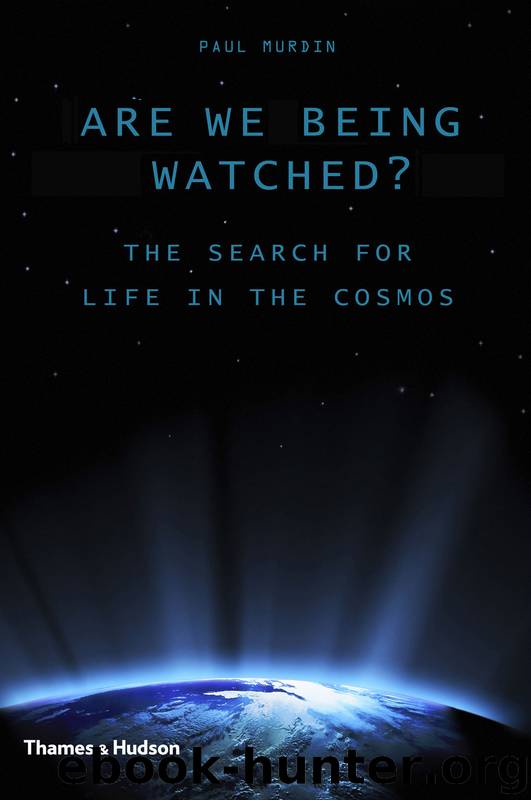Are We Being Watched? by Paul Murdin

Author:Paul Murdin
Language: eng
Format: epub
Publisher: Thames & Hudson
Published: 2013-04-25T16:00:00+00:00
10
The Sun: Source of Vital – or Death-dealing – Energy
The Sun is a star. Like all planetary systems, our Solar System depends on its star for its existence, stability and, at least in the inner zones, for warmth. Free-flying planets are feasible, and may indeed be very numerous, but, far from their parent star, they would be extremely cold places where life would struggle to survive, or even to begin. Stars support the main ecosystems in the Cosmos in which life is most readily possible.
The Sun exists in space as a mass of gas, principally hydrogen, which has contracted from a vast interstellar cloud of hydrogen atoms and arrived at a state in which it supports itself against its own force of gravity. The downward thrust has compressed the internal gases of the Sun and increased the density and pressure within. This compression has also heated the interior. The combination of density and heat means that the hydrogen atoms now collide with such force that they split to become electrons and protons. The protons crash together and, through nuclear reactions, fuse into helium nuclei. This releases nuclear energy, which heats the Sun’s material even more. In this way, the Sun creates enough internal, outwards-thrusting pressure to support its own enormous weight, and at the same time provides the radiation that warms our planet.
The Sun is highly stable because it is self-regulating. If, for some reason, it gets bigger, the pressure within reduces and the Sun settles back to its former size. On the other hand, if it gets smaller, the pressure and the density within increase, more energy is generated, and the Sun puffs up again. It maintains its broad characteristics over long periods. Not all stars are like this: some are variable, and change size sporadically or regularly, in hours, days or years. When this happens, they also change in temperature. The amount of energy a sun radiates depends on its surface area and temperature, so if it changes in size, any planets in proximity will become warmer or colder, accordingly. Life would likely be impossible on a planet with such a variable cosmic environment.
The Sun radiates a very broad spectrum of energy, primarily in the infrared, visible and ultraviolet wavelengths, but extending from radio wavelengths to energetic X- and gamma-rays. This energy warms the Earth to a temperature that is hospitable to life.
About 34 per cent of the Sun’s energy that reaches Earth is reflected back into space from the tops of clouds, ice and snow. Of the radiation intercepted by the Earth, 66 per cent is absorbed in one way or another, heats our planet, and is re-radiated back into space. The balance between the radiation that falls on Earth and that which is reflected back into space is what maintains the temperature of our planet. Changes in cloud or ice cover, and even, in recent times, aircraft condensation trails, affect this delicate balance.
* * *
As well as maintaining Earth at a habitable temperature and keeping most of the water here in liquid form, the Sun directly powers life-giving natural processes.
Download
This site does not store any files on its server. We only index and link to content provided by other sites. Please contact the content providers to delete copyright contents if any and email us, we'll remove relevant links or contents immediately.
| Aeronautics & Astronautics | Astronomy |
| Astrophysics & Space Science | Comets, Meteors & Asteroids |
| Cosmology | Mars |
| Solar System | Star-Gazing |
| Telescopes | UFOs |
Tools of Titans by Timothy Ferriss(8212)
Turbulence by E. J. Noyes(7935)
Secrets of Antigravity Propulsion: Tesla, UFOs, and Classified Aerospace Technology by Ph.D. Paul A. Laviolette(5309)
Astrophysics for People in a Hurry by Neil DeGrasse Tyson(5130)
Room 212 by Kate Stewart(5035)
Design of Trajectory Optimization Approach for Space Maneuver Vehicle Skip Entry Problems by Runqi Chai & Al Savvaris & Antonios Tsourdos & Senchun Chai(5011)
Pale Blue Dot by Carl Sagan(4907)
The David Icke Guide to the Global Conspiracy (and how to end it) by David Icke(4624)
A Journey Through Divination and Astronomy by Publishing Pottermore(4340)
Goodbye Paradise(3724)
Apollo 8 by Jeffrey Kluger(3635)
COSMOS by Carl Sagan(3553)
Losing the Nobel Prize by Brian Keating(3498)
The Five People You Meet in Heaven by Mitch Albom(3473)
How to Read Water: Clues and Patterns from Puddles to the Sea (Natural Navigation) by Tristan Gooley(3406)
Brief Answers to the Big Questions by Stephen Hawking(3369)
How to Read Nature by Tristan Gooley(3249)
The Order of Time by Carlo Rovelli(3144)
A Brief History of Time by Stephen Hawking(2959)
